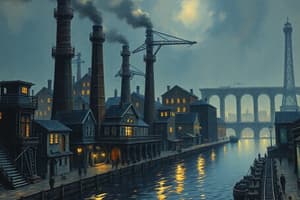Podcast
Questions and Answers
What was one of the major energy sources that replaced human and animal power during the Industrial Revolution?
What was one of the major energy sources that replaced human and animal power during the Industrial Revolution?
- Wind power
- Solar power
- Steam power (correct)
- Electric power
Which invention significantly changed textile production during the Industrial Revolution?
Which invention significantly changed textile production during the Industrial Revolution?
- Spinning jenny (correct)
- Power drill
- Cotton gin
- Mechanical loom
What was one of the social effects of the Industrial Revolution?
What was one of the social effects of the Industrial Revolution?
- Reduction of factory jobs
- Increased agricultural labor demand
- Decrease in urban populations
- Formation of new social classes (correct)
Which development contributed to the transportation advancements during the Industrial Revolution?
Which development contributed to the transportation advancements during the Industrial Revolution?
What agricultural advancement helped spur the Industrial Revolution by allowing for population growth?
What agricultural advancement helped spur the Industrial Revolution by allowing for population growth?
Which factor was NOT a cause of the Industrial Revolution?
Which factor was NOT a cause of the Industrial Revolution?
What was a significant environmental effect of the Industrial Revolution?
What was a significant environmental effect of the Industrial Revolution?
What major change did the Industrial Revolution bring to economies?
What major change did the Industrial Revolution bring to economies?
Flashcards
Industrial Revolution
Industrial Revolution
A period of rapid technological advancements marked by the shift from handmade goods to mass production using machines. It began in Britain in the late 18th and early 19th century and spread worldwide.
Mechanization
Mechanization
The process of using machines to replace manual labor in production, leading to increased efficiency and output.
Factories
Factories
Large buildings where goods are produced in a centralized, organized manner, marking a shift from traditional small workshops.
Urbanization
Urbanization
Signup and view all the flashcards
Energy Revolution
Energy Revolution
Signup and view all the flashcards
Agricultural Revolution
Agricultural Revolution
Signup and view all the flashcards
Abundant Resources
Abundant Resources
Signup and view all the flashcards
Industrial Revolution's Significance
Industrial Revolution's Significance
Signup and view all the flashcards
Study Notes
Industrial Revolution Overview
- A period of rapid industrial growth, occurring from the late 18th to early 19th centuries.
- Characterized by a transition from handmade goods to machine-based production.
- Originated in Britain, spreading globally.
Key Features
- Mechanization: Machines replaced manual labor, revolutionizing production, particularly in the textile industry (spinning jenny, power loom).
- Factory System: Centralized production in large factories, replacing small workshops.
- Urbanization: Mass migration to cities for factory jobs, fueling growth of industrial centers.
- Energy Transition: Shift from human/animal power to steam power (coal-based), exemplified by the steam engine (James Watt).
- Transportation Advancements: Development of railways, canals, roads, steam locomotives, and steamships.
Causes
- Agricultural Revolution: Improved farming techniques (crop rotation) created food surpluses, enabling population growth and labor mobility to factories.
- Technological Innovations: Crucial inventions like the spinning jenny, cotton gin, and steam engine.
- Abundant Resources: Britain's access to coal, iron, and navigable waterways.
- Capital and Trade: Wealth from trade fueled investment in machinery and factories.
Effects
- Economic Transformations: Growth of industries (textiles, iron, coal), emergence of capitalism and banking.
- Social Changes: Emergence of new social classes (e.g., industrial middle class, working class), but accompanied by poor living and working conditions in urban areas.
- Technological Advancements: Innovations in machinery, transportation, and communication, spurring further technological progress.
- Environmental Impacts: Increased pollution (air and water), deforestation, and resource depletion.
Significance
- Foundation of modern industry, fundamentally shifting economies from agrarian to industrial.
- A pivotal turning point in human history influencing global society, the economy, and technology.
Studying That Suits You
Use AI to generate personalized quizzes and flashcards to suit your learning preferences.




